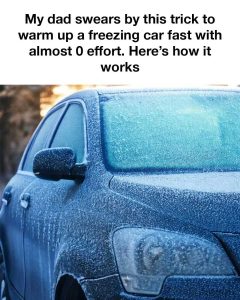Winter mornings are notorious for making even the simplest tasks feel like a chore, and one of the most dreaded among them is dealing with a freezing cold car. The idea of sitting behind the wheel shivering while waiting for the engine to warm up is something most of us could live without. It’s not just uncomfortable—it’s time-consuming, fuel-wasting, and frustrating. Yet, over the years, my dad has stuck to a trick that makes the whole warming-up process much faster and more efficient. He’s been using it every winter for as long as I can remember, and the results have always been impressive. In this article, I’ll share the method he uses, explain the science behind why it works, and show you how to use it in your daily routine so you can drive away in comfort without all the hassle.

To understand why your car doesn’t immediately blast warm air the second you start it, you need to get a sense of how your vehicle’s heating system works. Most cars use something called a heater core, which operates a lot like a small radiator. When your engine starts running, the coolant in your vehicle heats up as the engine warms. This hot coolant then circulates through the heater core, which acts like a heat exchanger. As air passes through the heater core, it gets warmed and then is blown into the cabin through your car’s vents. The big catch here is that this process doesn’t start effectively until the engine reaches its operating temperature—which can take anywhere from five to fifteen minutes on a cold day. That’s why your car blasts cold air at first, and why idling feels like it takes forever.
Most people try to speed this up by letting the engine idle for a few minutes before driving. Some use remote starters to fire up their car from indoors, so the interior is warm by the time they get in. Others rely on block heaters to warm the engine itself before they even turn the key. These are all valid approaches, but they each come with downsides—either they consume more fuel, require expensive equipment, or take longer than many of us are willing to wait. That’s where my dad’s trick really shines: it doesn’t require any fancy gear or a lot of time.
His trick is surprisingly simple. It involves making a quick adjustment to how your car’s ventilation system is set up right after you start the engine. The key idea is to help your vehicle heat up faster by changing the way the air is managed inside. Instead of waiting for the entire engine and cabin to warm up slowly, this method focuses on getting heat to the right places more quickly and efficiently, cutting down the total time it takes to feel warm and comfortable inside the car. It also helps reduce fuel usage and emissions because it minimizes unnecessary idling.
Here’s how you can do it: First, as soon as you start the car, turn the defroster on at full power. This clears the windshield of any frost or fog and is an essential step for safe visibility. Then, make sure the air system is set to recirculate the air already inside the car, rather than drawing in the freezing air from outside. This step is crucial because it allows the system to heat the air faster, since it’s not constantly replacing it with colder outside air. Next, set the temperature to the highest possible setting to kickstart the heating process. Once your windshield is clear and you’re ready to drive, switch the airflow from the windshield to the floor vents. Heat naturally rises, so warming the floor area will gradually make the entire cabin feel warmer. Finally, after a few minutes of driving, switch back to fresh air mode to prevent the windows from fogging up and to ensure good air circulation inside the cabin.
This method is effective for several reasons. First, it focuses the heating where it’s needed most—on the components and spaces that actually make you feel warmer, like the windshield and floor. Second, by recirculating already-warming interior air rather than battling the cold outside, the system can work more efficiently. Third, it gets you on the road faster without the guilt of wasting gas while idling unnecessarily. And because the car reaches optimal temperature while you’re driving—not while sitting still—it’s better for your engine and for the environment.
When you compare this to traditional methods, the differences are clear. Letting your car idle while you wait indoors might keep you out of the cold for a few minutes, but it’s wasteful and not very eco-friendly. Remote starters and block heaters can cost a lot and still require extra time to set up or plug in. In contrast, my dad’s method is free, easy to remember, and doesn’t involve any new tools or technology. It’s a smart use of what your car already has built in.
Of course, while this trick is generally safe and effective, there are a few safety precautions you should always keep in mind. Never warm up your car in a closed garage or poorly ventilated space. Doing so could lead to dangerous carbon monoxide buildup. Always make sure your exhaust pipe is clear of snow or ice to avoid blockages that can force harmful gases into the car. And don’t leave your vehicle running unattended—it’s not just unsafe, it’s illegal in some places. Make sure your car’s heating and ventilation systems are in good working condition with regular maintenance, especially as winter begins.
You might be wondering whether this trick works in all vehicles. The good news is yes—it’s compatible with most modern cars that use a standard heating system. While performance may vary slightly depending on the make and model, the principles behind the method hold true across the board. Even in extremely cold temperatures, it speeds things up compared to just letting your car idle in the driveway.
So, as winter rolls around and those frosty mornings become part of your routine, give this simple trick a try. It could save you time, fuel, and stress while making your drive far more comfortable. My dad has relied on it for years, and now it’s part of my daily habit every winter. Try it yourself and feel the difference the next time you head out on a cold morning.





